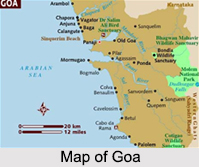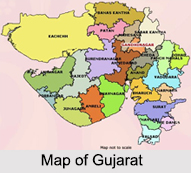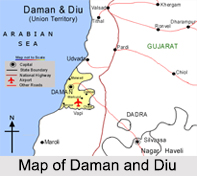 West Indian states consist of Goa, Gujarat, Maharashtra and Rajasthan along with the Union territory of Daman and Diu and Dadra and Nagar Haveli. The states differ drastically from one another in language, culture and levels of economic development. Maharashtra and Gujarat are among the most industrialized states of India while Rajasthan and Goa are magnets for tourists, though for different reasons.
West Indian states consist of Goa, Gujarat, Maharashtra and Rajasthan along with the Union territory of Daman and Diu and Dadra and Nagar Haveli. The states differ drastically from one another in language, culture and levels of economic development. Maharashtra and Gujarat are among the most industrialized states of India while Rajasthan and Goa are magnets for tourists, though for different reasons.
West Indian states are developed and industrialization helps to boost the economy with a large urban population of Pune, Mumbai, Thane and Panaji. The Western India states are bounded by the Thar Desert in the north-western part, the Vindhya Mountain Range in the north and the Arabian Sea in the west. A major portion of Western India shares the Deccan Plateau with South India.
History of West Indian States
Parts of Gujarat and Rajasthan in western India trace their history back to the Indus valley civilization. Lothal, Surkotada, and the region around Ghaggar river in Rajasthan are notable areas of excavation showing human inhabitance from 3300 BCE to 1300 BCE. Later the region was ruled by Rashtrakutas, Mauryas, Guptas, Rajputs, Satavahanas, Western Satraps, and Kadambas.
During the medieval age, Western India was ruled by Vaghela dynasty, Gujarat Sultanate, and Delhi Sultanate before the Mughals conquered it. Later, the Maratha Empire was defeat by the British in the Anglo-Maratha wars. The region became a hub of nationalist activities during the struggle for Indian Independence. Gandhi`s Dandi March took place in Gujarat. Western India became part of independent India in 1947, and the states were formed based on linguistic considerations in 1956.
Geography of West Indian States
Western part of India has predominantly arid to semi-arid regions of Saurashtra and Kutch in the North and Western Ghats along the coastal regions of South Gujarat, Maharashtra and Goa. The Deccan plains of the Vidarbha, Marathwada in central and eastern Maharashtra define the rest of the region. Vegetation varies from tropical rainforests along the Konkan coast to thorny bushes and shrubs in northern Gujarat. Rivers like Mahi, Narmada, Tapi, Godavari, Zuari, Mandovi, Krishna, Ghaggar, Chambal and many other smaller tributaries form natural water sources in this region.

Climate of West Indian States
The climate in western India usually varies from tropical wet to tropical wet and dry, and semi arid. Due to its proximity to the Arabian sea, the area witnesses little to no seasonal variations although the temperatures range between 20 degrees C to 38 degrees C. Temperature in Northern Konkan regions are comparatively lower with minimum temperature range of 12 degrees C. Central Maharashtra experiences hot summers with temperatures ranging up to 40 degrees C and winters see a drop in temperature to 10 degrees C. Gujarat and parts of Rajasthan that forms the western region of India have warm climate with hot summers and cool winters.
Language of West Indian States
Marathi is the most widely spoken language in western |India, followed by Gujarati and Konkani. There is a fair section of people who speak Indo-Aryan languages. Some people also speak Hindi and English.
Culture of West Indian States
Although the region is mainly inhabited by Hindus, people of other religion like Christian, Jains, Muslims, Buddhists, and Parsis are co-inhabiting with harmony. Western Indian states are also known for a wide population of different tribal communities. Each community has their unique cultural heritage reflected in their festivals, rituals, and dresses. From Garba and Rann utsav to Navratri and Christmas, West Indian states celebrate every festival in its full glory.
Cuisine of West Indian States
Due to its coastal location, many parts of Goa, Maharashtra, and Gujarat follows Konkani cuisine that is highly based on sea-food. In Gujarat and Rajasthan, the staple foods are corn, lentils and gram flour, dry red chilies, buttermilk, yogurt, sugar, and nuts. In Maharashtra, the culinary staples are fish, rice, coconut, and peanuts. In Goa, it`s fish and rice. Some of the popular Western Indian dishes are Bhelpuri, Thepla, Daal-Baati-Choorma, Laal Maas, Bebinca, and Ghewar.
 States of Western India
States of Western India
Western Indian states form the most heterogeneous region in India. Here is a brief description of all the states and union territories in Western India.
Goa
A kaleidoscopic blend of Indian and Portuguese cultures, Goa is India"s pocket sized paradise. This West Indian state lies within the coastal region known as the Konkan Coast. Goa is bounded by the state of Maharashtra to the north and Karnataka to the east and south, the Arabian Sea forms its western coast. It is India`s smallest state by area and the fourth smallest by population. Goa is popular for the beach resorts and night life. With better connectivity by air and rail, there has been an influx of people from neighbouring states that has led to different cultures in Goa. Many Indians from other states have now come and settled here.
Gujarat
Known for its stepped wells, Jain temples, Asiatic lion and its business oriented people, Gujarat is also called the "Jewel of Western India". It has an area of 196,024 sq. km with a coastline of 1,600 km, most of which lays on the Kathiawar Peninsula, and a population in excess of 60 million. Gujarat has many Hindu temples and the Jain pilgrimage centres. Gujarat is one of the West Indian states which are famous for its diverse culture, heritage and authentic cuisine.
Maharashtra
One of the West Indian states, Maharashtra is the third-largest state by area and is also the world`s second-most populous sub-national entity. It has over 112 million inhabitants and its capital, Mumbai, has a population of approximately 18 million. The state is primarily known for its ancient Ajanta and Ellora caves and other pilgrimage destinations.
Rajasthan
Rajasthan with its royal essence is the land of Maharajas, lakes and vibrancy, the state is known from the medieval era as the "Land of Kings". It is India`s largest state by area and is located on the north-western side of the country. The state of Rajasthan is where it comprises most of the wide and inhospitable Thar Desert and shares a border with the Pakistani provinces of Punjab to the northwest and Sindh to the west, along the Sutlej-Indus river valley. Rajasthan has the popular forts and temples and the medieval cities.
Dadra and Nagar Haveli
Dadra and Nagar Haveli is a union territory in Western India. It is composed of two separate geographical entities - Dadra an enclave surrounded by Gujarat and Nagar Haveli wedged between Maharashtra and Gujarat. The capital city is Silvassa. It lies within the north Western Ghats moist deciduous forests eco region, characterised by forests of teak and other dry season deciduous trees.
Daman and Diu
The union territory of Daman and Diu consists of two separate areas divided by the Arabian Sea. During the Portuguese era, Daman and Diu used to be a part of Goa but was incorporated into the Republic of India on 19th December 1961. It is the second smallest union territory and is known for its majestic beaches, forts and monuments which are seeped with history.






